Doctor profiles by Tracy LeGrand
Health boxes by Rebecca Fast
13. Dr. Chandan D. Lad

Family Medicine
Saint Francis Hospital; Warren Clinic
Tulsa
A native Tulsan, Chandan Lad, MD, matriculated through the University of Oklahoma College of Medicine and practices at Warren Clinic, calling it a natural fit to serve the community where he was raised.
“Family practice has always integrated components of many other specialties, giving physicians the opportunity to see how one medical condition can impact several others,” says Lad. “With the constant advancements in medications to treat so many different diseases, it has been a fascinating journey.”
Preventative care is something for which Lad has both passion and expertise. He says it involves modification of various aspects of health to prevent future disease, and that helping people to understand the importance of health maintenance holds the key to their quality of life in the future.
“A primary care provider must be prepared for questions on virtually any topic in medicine,” he says. “My day often involves helping people from a wide range of ages, cultures and socioeconomic backgrounds with a wide range of health concerns and chronic ailments. The greatest reward comes when another person better understands their health, thinking ‘Wow, no one has ever explained it to me that way.’
“Through the pandemic, many people may have postponed their preventive health measures. It’s important that people continue to get those screenings. Discussing advanced methods of screening for diseases and the role of new vaccinations continue to hold daily importance. The emergence of virtual healthcare as a new tool for patients and providers to use, especially during the pandemic, was very beneficial as well.”
12. Dr. Brian Chalkin
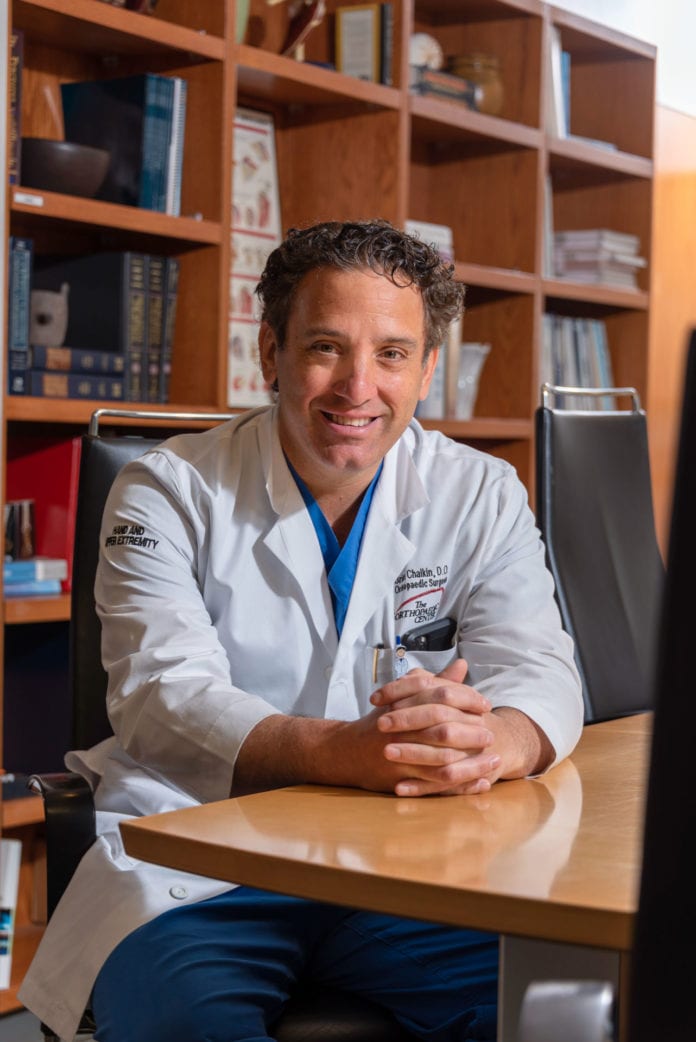
Orthopaedic Surgery
The Orthopaedic Center, Bristow Medical Center, Ascension St. John Medical Center
Tulsa
It was the serendipity of his wife’s Tulsa origins and a position he could fill that led to Brian Chalkin, D.O., joining the Orthopaedic Center in 2004 after training as an upper extremity specialist.
A typical day begins with patient visits, emergency add-ons and post-operative follow-up visits, says Chalkin.
“People will often arrive in temporary splints or dressings that have been applied in emergency room settings or urgent care centers,” he says. “They frequently are seeking a better understanding of their individual problem.”
Chalkin has seen several welcome breakthroughs in his field.
“The reverse total shoulder has revolutionized the way we treat rotator cuff tears in the elderly and/or people who have had failed rotator cuff repairs,” he says. “This implant is used to restore function and relieve pain for patients that, in the past, would suffer day and night with pain and inability to raise their arm. The implant and the technique have been improved dramatically in the last 15 years, and now have good long term data providing excellent results.”
Chalkin would like to see people seek help if suffering from arm pain, deformity or dysfunction, injury or degenerative process … even if they think they know the root of the issue.
“Try not to blame your pain on ‘arthritis’ and suggest that there is nothing that can be done until you see an orthopedic specialist in the field,” he says. “There may be options for treatment that can improve your quality of life.”
11. Dr. Scott Lucas

Thoracic and Cardiac Surgery
SSM Health St. Anthony Hospital
OKC
Scott Lucas, MD, began his medical journey at the University of Oklahoma Medical School, with residency at OU Health Services and a professorship of cardiac surgery at OU. He later entered private practice, which includes working at SSM Health St. Anthony Hospital in OKC.
His interest in the heart started early.
“From a young age, I was always drawn to heart anatomy and function,” says Lucas. “I have drawings that I made of the heart at age six. In high school, I read books about the pioneers in heart surgery; heart surgery involves the basic rhythm of life to me.”
With special interests including cardiac valve repair and aortic aneurysm repair, a typical day for Lucas includes rounds and multiple surgeries. He says the greatest rewards include helping patients – and their families – recover from life-threatening problems and “being asked to operate on my colleagues and their families.”
Having witnessed a huge evolution in heart surgery so far in his career, Lucas describes his particular field of medicine as “incredibly gratifying – it is to literally mend a broken heart.” He is excited about breakthroughs in his field, and references minimally invasive surgery to include transcatheter valve replacements (replacing a heart valve through groin artery access only, not by opening the chest) and endovascular aneurysm repair (repairing an aortic aneurysm with access through a groin artery rather than opening a body cavity.)
10. Dr. Reba Beard
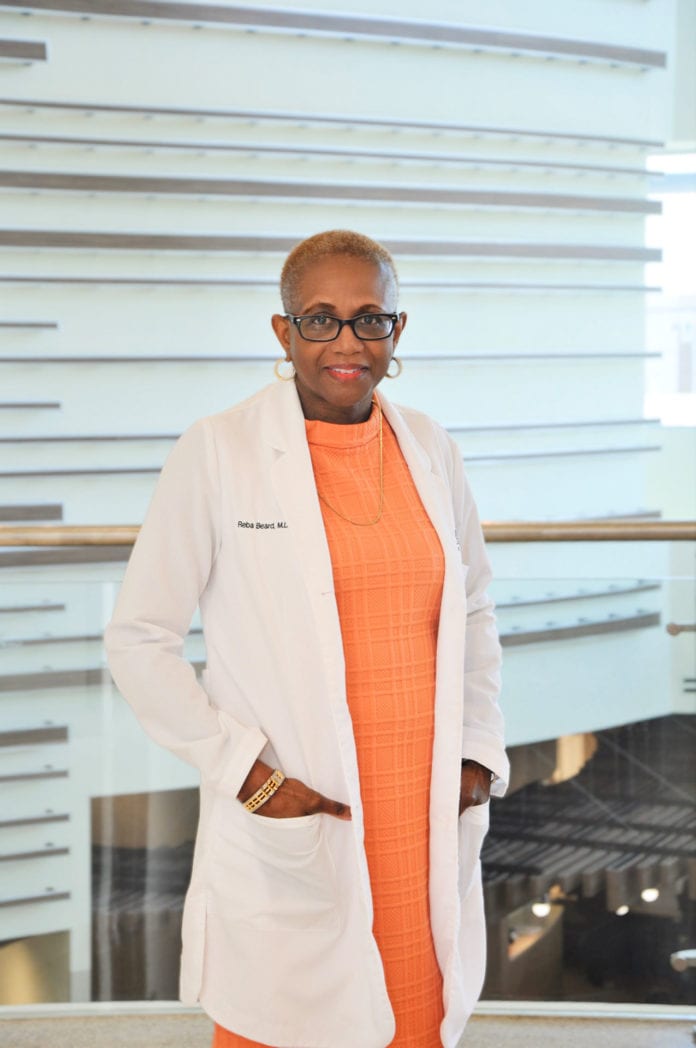
Pediatrics
Norman Regional Hospital
Norman
After attending Louisiana State University Medical Center in Shreveport, La., Reba Beard moved to the Children’s Hospital of Oklahoma with a pediatric internship and residency, eventually coming to practice pediatric medicine at Moore Norman Hospital and also making rounds in the nursery at Norman HealthPlex.
“As pediatricians, we seek to provide the preventive, maintenance and ongoing care and welfare of children with the continuing emphasis on research to improve that care of children,” says Beard. “I chose pediatrics because I love children, and believe each child is entitled to be respected. Initially, I considered teaching, but the one on one attention given to parents and their children suited me better. I felt I could give a better impact in children’s lives caring for them from day one in partnering with their parents.”
That partnership includes preventative measures.
“I have seen enormous benefits, especially from immunizations over the years to curb the illness and their complications that are included in the vaccines,” she says. “So many lives have been saved and complications prevented from them. It has been remarkable and essential to the health and wellbeing of children.
“Each day and moment to have the opportunity to be of service to parents and their children is a privilege and honor. I have enjoyed each aspect of my work.”
9. Dr. Lieschen H. Quiroz
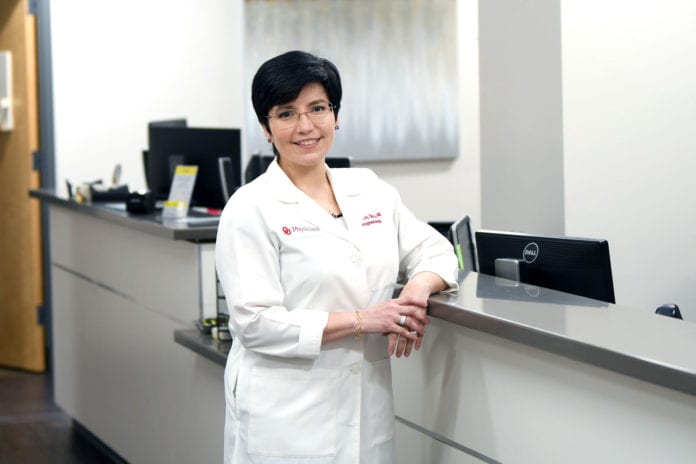
Urogynecology/Female Pelvic Medicine and Reconstructive Surgery
OU Medicine
OKC
Lieschen H. Quiroz, MD, serves as OU Health Chief of Female Pelvic Medicine and Reconstructive Surgery. Her goal is to help women no longer suffer in silence.
“I always had an interest in women’s health,” she says. “Urogynecology allows me to provide care to women beyond the year of childbearing age. Pelvic floor disorders are common, and women often don’t seek care for these problems due to embarrassment. They prefer to ignore these symptoms and try to live with them. Conditions such as pelvic organ prolapse and urinary incontinence are often associated with a history of childbirth trauma. My area of interest within urogynecology includes pelvic floor imaging, 3D ultrasound and childbirth trauma.”
Between teaching, hospital rounds, clinic hours seeing patients and twice weekly surgery days, Quiroz is well-versed in the latest technologies within her field.
“Being involved in academic medicine means that our patients will always be offered the newest, cutting edge, well-studied treatments,” she says. “The novel use of 3D ultrasound is one of my areas of expertise, and I’m one of the few experts in this field with national and international recognition for my work. I’m happy to provide these services to the women in Oklahoma and surrounding states.”
8. Dr. Deana Watts

Ophthalmology
Dean McGee Eye Institute, OU Medical Center
OKC
For Deana Watts, MD, becoming a champion of eyesight was always the goal.
“Ophthalmology is a very rewarding field of medicine,” she says. “Vision plays such a big part in a person’s quality of life, and it is an honor to be entrusted with caring for a patient’s ocular health. My favorite part of my job is having the opportunity to meet patients and getting to know them – I love visiting with people in clinic and playing a role in their health care.”
Watts, a graduate the University of Oklahoma College of Medicine, completed her ophthalmology residency at UT Southwestern in Dallas, and practiced in Wichita Falls before moving to Oklahoma to work at the esteemed Dean McGee Eye Institute. There, she also supervises residents as a dedicated faculty member, overseeing care for clinic patients.
“The most rewarding part of my career is the opportunity to be a part of training ophthalmology residents,” she says. “My primary role with them is staffing the resident clinic. Resident clinic is truly one of the best places to practice medicine – the patient population is diverse and often, we are providing care to patients with significant and challenging medical needs.
“We see patients who are following up from emergency room visits for a wide range of ophthalmic emergencies, as well as scheduled patients who are coming in for routine eye care.”
7. Dr. Jess Armor

Medical Oncology
Mercy Hospital
OKC
A Laverne, Okla., native, Jess Armor, MD, graduated from medical school at the University of Oklahoma and continued his training at the University of Utah Medical Center before returning to OU Health Sciences for a medical oncology fellowship.
He now treats patients at Cancer Care Associates at Mercy Hospital, which is on the forefront of the growing field of therapeutics for patients with cancer.
Armor is encouraged by breakthroughs in oncology, and says the biggest and most far-reaching is “probably the expanding field of anti-cancer immunotherapy,” he says. “Immunotherapy drugs have been developed in recent years to allow the body’s immune system to recognize cancer cells and attack them. Clinical trials with immunotherapy have shown significant improvements in survival of cancers, including those for which there previously was no good therapy.” A strong example of these breakthroughs comes from patients with melanoma.
“Now, patients with stage IV melanoma have a published median survival rate of five years, thanks to breakthroughs in the immuno-oncology field. When I first started, the median survival was around nine months,” he says. “I have multiple patients that have benefitted greatly from these new therapies, which, in general, spare many of the usual side effects of traditional chemotherapy. Furthering the field of immunotherapy is the development and use of CAR-T therapy, which molecularly modifies immune cells to become warriors to attack cancer cells.”
6. Cataracts
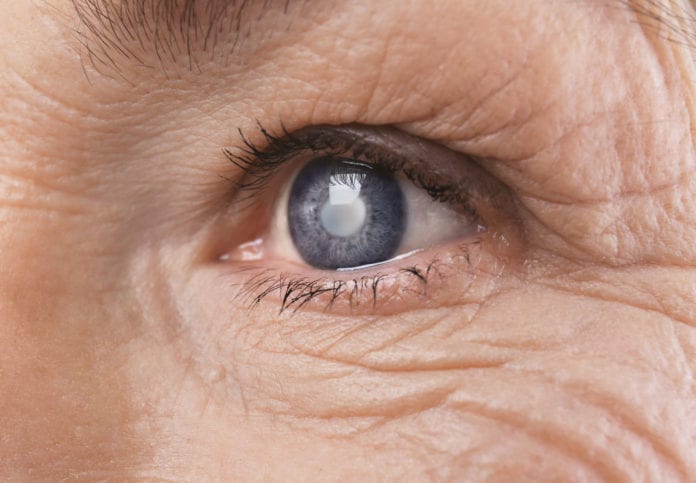
Cataracts are caused by a buildup of protein in the lens of the eye which keeps light from passing through clearly. There are many types of cataracts, and symptoms can include blurred vision, nearsightedness, double vision, changes in the way you see color, problems driving at night and/or problems with glare during the day. While cataracts are a common condition for older adults, some babies are born with them – known as congenital cataracts – and some children develop cataracts. Causes for cataracts in children can include eye injury, diabetes, complications from eye problems, radiation treatment and steroids.
Source: webmd.com
5. Sleep Disorders

Like an overdrawn bank account, a lack of sleep results in a sleep debt that can affect your judgment, reaction time and other cognitive functions. If you struggle with sleep, developing healthy sleep habits is key.
Allow time for sleep – Go to bed early enough for a full night’s rest.
Keep a sleep schedule – Go to bed and get up around the same time every day, even on weekends.
Create a sleep sanctuary – Keep your bedroom dark, quiet and at a comfortable temperature.
Have a bedtime routine – Avoid bright lights, large meals, caffeine and alcohol before bed.
Exercise daily – Try for 30 minutes of exercise a day, at least five hours before bed.
Seek help, if needed – Visit your doctor for help with any medical conditions that may be affecting your sleep. Common sleep problems include snoring, sleep apnea, insomnia, sleep deprivation and restless leg syndrome.
Source: webmd.com
4. Cholesterol Management

There are simple and effective ways to manage your cholesterol.
Know Your Numbers: The American Heart Association recommends adults aged 20 and older to have their cholesterol checked every four to six years. A lipid panel is a blood test that provides results for HDL (good) cholesterol, LDL (bad) cholesterol, triglycerides and total blood (or serum) cholesterol.
Eat a Heart Healthy Diet: To help lower your cholesterol through diet, reduce your intake of saturated fat, trans fat and sodium. Limit the amount of red meat and dairy products you eat, as well as sugar-sweetened foods and beverages. Instead, focus on eating fruits, vegetables, whole grains, poultry, fish, nuts and nontropical vegetable oils.
Quit Smoking: Smoking and vaping lowers HDL (good) cholesterol and increases your risk of coronary heart disease.
Get Active and Lose Weight: A minimum of 150 minutes of moderate-intensity aerobic exercise a week can lower both cholesterol and high blood pressure while a weight loss of as little as 5% to 10% can help improve cholesterol numbers.
Source: American Heart Association, heart.org
3. Joint Health

Everyday wear and tear on your joints along with age, injury or weight gain can make movement painful. To help keep your joints healthy and improve mobility, consider the following tips:
Keep your weight within a healthy range to help ease the strain on your joints.
Incorporate low-impact exercises into your fitness routine, such as swimming or bicycling.
Do weight training exercises to strengthen the muscles and ligaments that support your joints, and progress slowly to prevent injury.
Eat a healthy diet; calcium, lean protein and vitamin D are essentials for healthy joints and muscles.
Source: webmd.com
2. Kidney Stones
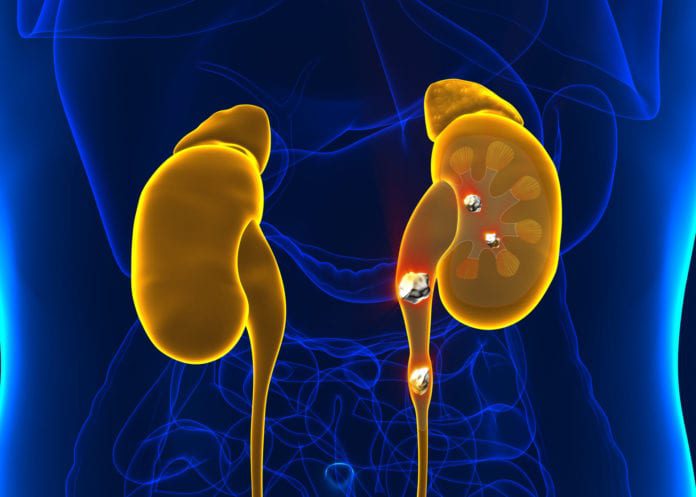
The pain of passing a kidney stone can be severe. Kidney stones are hard deposits of minerals and salts that form within the kidneys. Causes can include diet, excess body weight, some medical conditions, and certain supplements and medications.
Symptoms can include severe, sharp pain in the side and back – below the ribs, pain that radiates to the lower abdomen and groin and/or comes in waves and fluctuates in intensity and/or pain or burning sensation while urinating.
Source: mayoclinic.org
1. Diabetes Differences

Diabetes is a chronic disease that affects how your body uses blood sugar (glucose). The most common types of diabetes – type 1 and type 2 – share symptoms but differ in cause.
Type 1 Diabetes: The immune system attacks and destroys the insulin-producing cells in the pancreas, causing it to produce very little insulin or no insulin at all. It can develop at any age but most often appears during childhood or adolescence. Symptoms tend to come on quickly and be more severe.
Type 2 Diabetes: The body’s cells become resistant to insulin and the pancreas is unable to produce enough insulin to overcome this resistance. It can develop at any age but is more common in people over 40. Symptoms usually develop slowly.
Source: mayoclinic.org






















